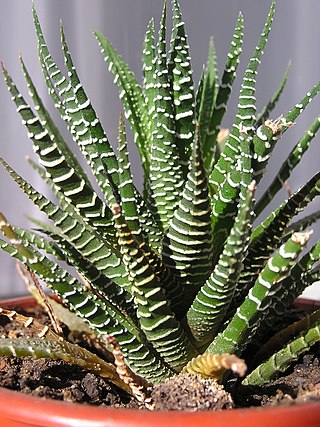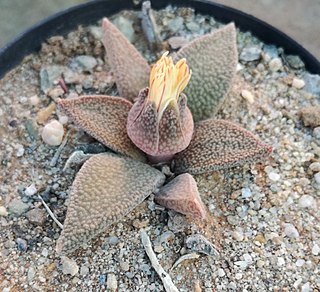
Haworthia is a large genus of small succulent plants endemic to Southern Africa (Mozambique, Namibia, Lesotho, Eswatini and South Africa).

In botany, succulent plants, also known as succulents, are plants with parts that are thickened, fleshy, and engorged, usually to retain water in arid climates or soil conditions. The word succulent comes from the Latin word sucus, meaning "juice" or "sap".

Haworthiopsis reinwardtii, formerly Haworthia reinwardtii, is a species of succulent flowering plant in the family Asphodelaceae, native to the Eastern Cape Province of South Africa. It is one of the species of Haworthiopsis that is commonly cultivated as an ornamental.

Cheiridopsis denticulata is a species in the genus Cheiridopsis native to South Africa. It has yellow flowers, and distinctive foliage with a narrow, upward curving shape. Commonly called "pink fingers", the leaves grow in opposite pairs and are light blue with sun exposure blushing them shades of pink and purple.

Cheiridopsis pillansii is a species of plant in the genus Cheiridopsis native to South Africa. It is a low-growing succulent with pairs of small, cushion-like leaves that are pale green to purple in color. C. pillansii, sometimes commonly called the "hoof mesemb", forms clumps up to 500 millimetres (20 in) wide.

Tulista pumila ("Vratjiesaalwee") is a species of Tulista succulent plant, from the Western Cape, South Africa.

Aloeae is a tribe of succulent plants in the subfamily Asphodeloideae of the family Asphodelaceae, consisting of the aloes and their close relatives. The taxon may also be treated as the subfamily Alooideae by those botanists who retain the narrower circumscription of Asphodelaceae adopted prior to the APG III system. Typically, plants have rosettes of more or less succulent leaves, with or without a distinct stem. Their flowers are arranged in racemes and tend to be either small and pale, pollinated by insects, or larger and more brightly coloured, pollinated by birds. As of 2017, 11 genera are recognized, most created since 2010 by splitting off another five genera from Aloe and another two from Haworthia. Only two genera, Aloe and Aloidendron, are native outside southern Africa, extending northwards to the Arabian Peninsula. Seven genera are restricted to South Africa, some with small ranges. Members of the Aloeae are cultivated by succulent plant enthusiasts; Aloe species especially are used in temperate climates as ornamental garden plants. Some species are used in traditional medicine. Aloe vera and Aloe ferox are cultivated for their extracts, whose uses include moisturizers and emollients in cosmetics.

Haworthiopsis is a genus of succulent plants in the subfamily Asphodeloideae. The genus was previously included in Haworthia. Species in the genus are typically short perennial plants, with leaves often arranged in a rosette and frequently having raised white markings. The two-lipped flowers are borne on a tall stalk and are small – less than 17 mm (0.7 in) long – and pale in colour. Many species are cultivated as house plants or by succulent enthusiasts.

Haworthia turgida, also sometimes known as the windowpane plant, is a species of Haworthia native to the Cape Provinces. Its common name comes from the translucent panes on its leaves, which are similar to those of Haworthia cooperi and some other species in the genus. It grows in dense clusters of offsets from the base, and in its native habitat prefers rocky limestone or slate cliffs. The main type has pale green leaves but varies widely. Varieties include Haworthia turgida var. longibracteata (M.B.Bayer) and Haworthia turgida var. suberecta (Poelln.)

Haworthia parksiana is a species of succulent plant native to the Western Cape of South Africa. Regarded as the smallest and one of the rarest types of Haworthia in the wild, it is thought to be most closely related to Haworthia floribunda. It grows in rosettes up to about 4 centimetres (1.6 in) in diameter, and is often hidden in the ground.

Aloe haworthioides is a species of plant in the genus Aloe native to Madagascar. This aloe is named for its leaves, which are covered with soft spines that create a resemblance to Haworthia species. A small species, it grows in stemless, clumping offsets and sports orange, highly fragrant flowers.

Haworthia mutica is a species of succulent plant native to South Africa's Cape Province. Very similar to, and often confused with, types such as Haworthia retusa, the species has blunt, triangular shaped leaves that are typically striated. In the wild it rarely offsets, though clones in cultivation may do so readily. The variety H. mutica var nigra is similar but with darker leaf color.

Haworthia chloracantha is a species of succulent plant native to the Cape Province of South Africa. H. chloracantha has typically pale yellow-green leaves and is somewhat similar to Haworthia reticulata in form, but the leaves are opaque rather than translucent. It forms prolific clusters of plants. The plant has a few subvarieties including var. denticulifera, meaning has small teeth on its leaves, and var. subglauca, which has darker foliage.

Haworthia lockwoodii is a species of succulent plant in the genus Haworthia. Native to the Cape Province of South Africa, it was named for a local magistrate.

Haworthia herbacea is a species of succulent plant in the genus Haworthia native to the Cape Province of South Africa. Closely related to Haworthia reticulata, it has greenish yellow leaves with small spines. As it matures the leaves get darker green and the white spots raise. Flowers by way of a shoot and produces a large off-white flower.

Aloinopsis luckhoffii is a species of succulent plant in the genus Aloinopsis native to South Africa. Like other Aloinopsis it grows in a rosette of leaves close to the ground. It has angular leaves that are covered by small, white tooth-like protrusions.

Aloinopsis rubrolineata is a species of succulent plant in the genus Aloinopsis native to South Africa. It grows in a branching habit low to the ground, and has leaves covered with small, round tubercles. The leaves are dark olive green and tongue-like in shape. Its scientific name refers to its flowers, which have a distinctive red stripe.

Aloinopsis spathulata is a species of succulent plant in the genus Aloinopsis native to South Africa. It has spoon-shaped green leaves patterned with tubercles, and unlike the yellow flowers of most in its genus, it has magenta to pink blooms. Able to grow in Sutherland, the coldest town in South Africa, it is particularly frost hardy.

Crassula tecta is a species of succulent plant in the genus Crassula native to South Africa. Easily confused with Crassula namaquensis, this species has a compact growth habit forming clusters of round, blue-white leaves. Kept in cultivation since the 18th century, Crassula tecta is known for the beautiful patterning on its leaves and white flowers.

Haworthia reticulata is a species of succulent plant native to the southwestern Cape Provinces of South Africa. The species has several varieties, including var. hurlingii which is the smallest at up to 1 inch (2.5 cm) wide.




















